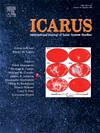Correction for calcium interference in the 40Ar/39Ar dating method
IF 2.5
2区 物理与天体物理
Q2 ASTRONOMY & ASTROPHYSICS
引用次数: 0
Abstract
Since the inception of the 40Ar/39Ar dating method, it has been recognized that fast neutrons can interact with nuclides in the sample beyond 39K, resulting in the production of interfering argon isotopes. Correction factors for these side effects have been proposed from many nuclear reactors globally. However, current practice does not always involve the monitoring of these correction factors for every sample batch, but is reliant on previous results instead. This approach is justified by the limited variability observed in the (36Ar/37Ar)Ca and (39Ar/37Ar)Ca correction factors, and such limited variability is acceptable for samples with high K/Ca ratio. For low K/Ca samples, however, even minor variations in the correction factors can significantly impact the accuracy of the results. Here, we evaluate the performance of optical grade CaF2 crystals and spectrally pure-grade CaF2 to monitor the correction factor for the calcium interference. The results demonstrate that the optical grade CaF2 crystals yield consistently reliable calcium correction factors when subjected to stepwise heating and single grain total fusion. Therefore, we recommend the use of optical grade CaF2 crystals for monitoring potential calcium interference. Furthermore, we advocate for the continuous monitoring of calcium correction factors during each sample irradiation. When analyzing extraterrestrial samples, the optical grade CaF2 crystals should be positioned adjacent to the samples. As a standard product, optical grade CaF2 crystals are readily accessible to 40Ar/39Ar laboratories worldwide.
40Ar/39Ar定年法中钙干扰的修正
自40Ar/39Ar定年法开始以来,人们已经认识到快中子可以与样品中超过39K的核素相互作用,从而产生干扰氩同位素。全球许多核反应堆都提出了这些副作用的修正系数。然而,目前的做法并不总是涉及对每个样品批次的这些校正因子的监测,而是依赖于以前的结果。在(36Ar/37Ar)Ca和(39Ar/37Ar)Ca校正因子中观察到的有限变异性证明了这种方法是合理的,这种有限的变异性对于高K/Ca比的样品是可以接受的。然而,对于低K/Ca样品,即使校正因子的微小变化也会显著影响结果的准确性。在这里,我们评估了光学级CaF2晶体和光谱纯级CaF2晶体的性能,以监测钙干涉的校正因子。结果表明,在逐级加热和单晶全熔过程中,光学级CaF2晶体的钙校正因子稳定可靠。因此,我们建议使用光学级CaF2晶体来监测潜在的钙干扰。此外,我们主张在每次样品辐照期间持续监测钙校正因子。在分析地外样品时,光学级CaF2晶体应放置在样品附近。作为标准产品,光学级CaF2晶体很容易在全球40Ar/39Ar实验室获得。
本文章由计算机程序翻译,如有差异,请以英文原文为准。
求助全文
约1分钟内获得全文
求助全文
来源期刊

Icarus
地学天文-天文与天体物理
CiteScore
6.30
自引率
18.80%
发文量
356
审稿时长
2-4 weeks
期刊介绍:
Icarus is devoted to the publication of original contributions in the field of Solar System studies. Manuscripts reporting the results of new research - observational, experimental, or theoretical - concerning the astronomy, geology, meteorology, physics, chemistry, biology, and other scientific aspects of our Solar System or extrasolar systems are welcome. The journal generally does not publish papers devoted exclusively to the Sun, the Earth, celestial mechanics, meteoritics, or astrophysics. Icarus does not publish papers that provide "improved" versions of Bode''s law, or other numerical relations, without a sound physical basis. Icarus does not publish meeting announcements or general notices. Reviews, historical papers, and manuscripts describing spacecraft instrumentation may be considered, but only with prior approval of the editor. An entire issue of the journal is occasionally devoted to a single subject, usually arising from a conference on the same topic. The language of publication is English. American or British usage is accepted, but not a mixture of these.
 求助内容:
求助内容: 应助结果提醒方式:
应助结果提醒方式:


